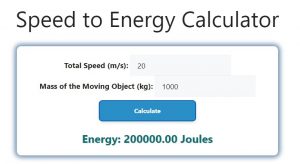About Speed to Energy Calculator (Formula)
The Speed to Energy Calculator is a useful tool for understanding the relationship between an object’s speed and its kinetic energy. In physics, energy is defined as the capacity to do work, and kinetic energy is the energy an object possesses due to its motion. By calculating energy based on speed and mass, users can gain valuable insights into various applications, including automotive engineering, sports science, and physics experiments. This calculator simplifies the process, allowing for quick and accurate energy assessments.
Formula
The formula to calculate energy is as follows:
Energy (E) = 0.5 * (Speed^2) * Mass
Where:
- Energy (E) is the kinetic energy measured in joules (J).
- Speed is the velocity of the object in meters per second (m/s).
- Mass is the mass of the object in kilograms (kg).
How to Use
- Determine Speed: Measure or obtain the speed of the object in meters per second (m/s).
- Determine Mass: Measure or obtain the mass of the object in kilograms (kg).
- Apply the Formula: Plug the values of speed and mass into the formula to calculate the kinetic energy.
- Analyze Results: Interpret the calculated energy in the context of your specific application.
Example
Let’s say we have a car with a mass of 1,000 kg that is traveling at a speed of 20 m/s. To calculate the kinetic energy, we can use the formula:
Energy (E) = 0.5 * (20^2) * 1000
Energy (E) = 0.5 * 400 * 1000
Energy (E) = 200,000 J
Thus, the kinetic energy of the car is 200,000 joules.

FAQs
- What is a Speed to Energy Calculator?
A Speed to Energy Calculator is a tool that calculates the kinetic energy of an object based on its speed and mass. - Why is kinetic energy important?
Kinetic energy is crucial for understanding the motion of objects and plays a significant role in fields like physics, engineering, and sports. - How is energy measured?
Energy is typically measured in joules (J). - What units are used for speed?
Speed is measured in meters per second (m/s). - What units are used for mass?
Mass is measured in kilograms (kg). - Can this calculator be used for any object?
Yes, the Speed to Energy Calculator can be used for any object as long as you have the speed and mass. - What happens to energy if speed increases?
Kinetic energy increases exponentially with speed due to the square relationship in the formula. - Can I use the calculator for different units?
The formula requires speed in meters per second and mass in kilograms for accurate results. - What is the relationship between mass and kinetic energy?
Kinetic energy is directly proportional to the mass of the object; as mass increases, kinetic energy increases. - What factors affect an object’s kinetic energy?
The primary factors affecting kinetic energy are the object’s speed and mass. - How does this apply in real-life scenarios?
Understanding kinetic energy can help in vehicle safety design, sports performance analysis, and accident reconstruction. - Is there a maximum speed limit for this calculation?
The formula applies universally, but relativistic effects at very high speeds (close to the speed of light) are not considered. - Can I calculate energy without knowing the mass?
No, both speed and mass are required to calculate kinetic energy. - What is the significance of the 0.5 in the formula?
The 0.5 factor accounts for the kinetic energy formula derived from work-energy principles in physics. - Is this calculator useful for sports analysis?
Yes, it can be applied in sports to analyze the performance and energy exertion of athletes. - Can I use this formula for objects in free fall?
Yes, the kinetic energy of objects in free fall can be calculated using this formula. - What is the difference between kinetic and potential energy?
Kinetic energy is energy due to motion, while potential energy is stored energy based on position or condition. - How does the Speed to Energy Calculator aid in safety?
It helps engineers design safer vehicles and systems by understanding the energy involved in impacts. - What happens to energy during a collision?
During a collision, kinetic energy may be transformed into other forms of energy, such as heat and sound. - Where can I find more information on kinetic energy?
Additional information can be found in physics textbooks, online resources, and educational videos.
Conclusion
The Speed to Energy Calculator is an invaluable tool for anyone interested in understanding kinetic energy and its implications in various fields. By applying the formula, users can quickly calculate the energy of an object based on its speed and mass, allowing for practical applications in engineering, sports science, and beyond. Understanding kinetic energy is essential for designing safer systems and improving performance, making this calculator a must-have for students, professionals, and enthusiasts alike.